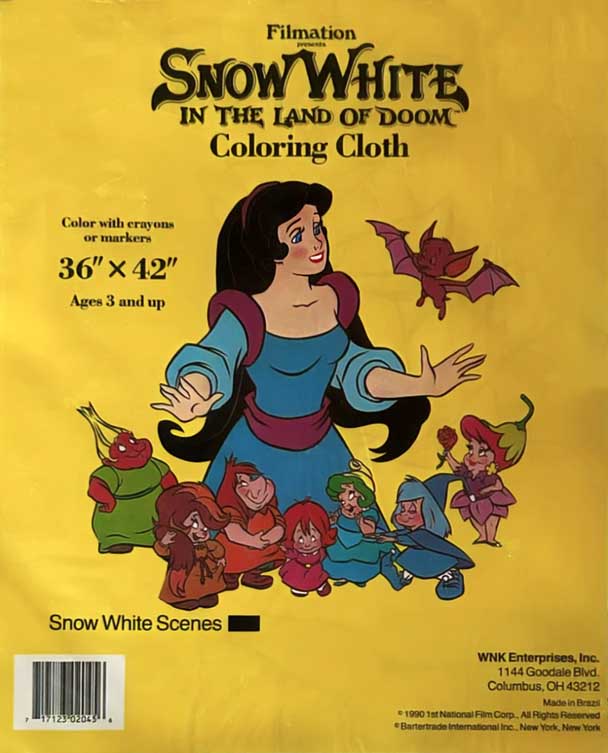Production information
Release dates: May 28, 1993 (USA), 2022 – June 20, 1990 (France)
Studios: Filmation Associates & Kel Air Productions
Director: John Howley
Writers: Martha Moran & Robby London
Composer: Frank W. Becker
Producer: Lou Scheimer
Associate producers: John Grusd, Robby London & Erika Scheimer
Art Direction: Cheryl Bascom
Editors: Joe Gall, Rick Gehr & Jeff Patch
Production Designers: Ray Aragon, Gerald Forton, Frank Frezzo, Tenny Henson, Rick Maki, Leandro Martinez, Tom Shannon, Cliff Voorhees & Patricia Wong
Casting: Cheryl Bascom
Main Cast
Snow White: Irene Cara
Lord Malice: Malcom McDowell
The Prince: Michael Horton
The Looking Glass: Dom Deluise
Mother Nature: Phyllis Diller
Scowl: Edward Asner
Muddy: Carole Channing
Blossom: Zsa Zsa Gabor
Critterina: Linda Gary
Marina: Linda Gary
Sunburn: Sally Kellerman
Moonbeam: Tracey Ullman
Thunderella: Tracey Ullman
Sunflower: Jonathan Harris
Batso: Frank Welker
The Manticore: Brian Cummings
Bunny: Brian Cummings
Bumblebee: Brian Cummings
Back to References to Snow White from other studios

A Tale of Troubled Production
The animated film Happily Ever After is a fascinating piece of animation history. Billed as an unofficial sequel to Walt Disney’s Snow White and the Seven Dwarfs, it reimagines the life of Snow White after her marriage to the Prince. However, the film’s turbulent production, shifting titles, and unconventional release strategy have contributed to its reputation as both an ambitious and troubled project.
A New Chapter for Snow White
In Happily Ever After, Snow White’s happily-ever-after is disrupted by Lord Maliss, the vengeful brother of the Evil Queen. Snow White must embark on a perilous journey, meeting magical allies called the Seven Dwarfelles, each representing a natural element. While echoing elements of Disney’s 1937 masterpiece, the film sought to offer a fresh take on the beloved character, focusing on themes of courage and independence.
Unlike Disney’s Snow White, Happily Ever After was produced by Filmation, a studio known for its budget-conscious approach. While the film was clearly inspired by Disney’s legacy, Filmation had to create an original style and storyline due to legal restrictions, avoiding direct duplication of Disney’s designs or story elements.


Working Titles and Evolution of the Project
The production of Happily Ever After underwent numerous changes, including a series of working titles that reflected its shifting direction. Early in development, the film was known as Snow White in the Land of Doom, a title emphasizing its darker, adventure-driven tone. Later, it was rebranded as Snow White and the Realm of Doom, continuing to highlight its fantasy elements. As production progressed, the project became Snow White and the Seven Dwarfelles, placing greater focus on the film’s magical allies. There was a 1989 release in the Philippines with the title Snow White: The Adventure Continues, a phrase that was used as a subtitle on some later video releases as well. In France, the film came out as early as 1990 as Snow White and the Haunted Castle.
Finally, the title was simplified to “Happily Ever After” when it was released in 1993 in the United States, signaling a broader appeal and emphasizing its status as a continuation of Snow White’s story. These title changes reveal the creative and marketing challenges of positioning the film as both a spiritual successor to Disney’s classic and an independent work.
When the film finally arrived in American theaters, it struggled to find an audience. The dated animation and modest production values paled in comparison to Disney’s modern blockbusters like Beauty and the Beast and Aladdin. Despite this, Happily Ever After gained a cult following, with fans appreciating its nostalgic charm and unique take on Snow White’s story.
A Star-Studded Voice Cast
Irene Cara, celebrated for Fame and the Oscar-winning song “Flashdance… What a Feeling,” voiced Snow White. Her contemporary vocal style added a fresh dimension to the iconic character.
Malcolm McDowell, best known for A Clockwork Orange and Star Trek: Generations, voiced the villainous Lord Maliss. His commanding presence and reputation for dark, complex roles made him an ideal fit.
Broadway legend Carol Channing (Hello, Dolly!, Thoroughly Modern Millie) played Muddy, the Dwarfelle of Earth. Her distinctively quirky voice brought charm and humor to the role.
Zsa Zsa Gabor, the glamorous star of Moulin Rouge and Queen of Outer Space voiced Blossom, the Dwarfelle of Flowers. Her signature elegance infused the character with a sophisticated flair.
Dom DeLuise, known for Blazing Saddles and An American Tail, voiced The Looking Glass. His trademark humor made the magical mirror a standout source of comic relief.
Edward Asner (The Mary Tyler Moore Show, Lou Grant) voiced Scowl, a clumsy owl. His gruff yet endearing tone added depth and humor to the character’s arc.
Tracey Ullman, the comedian behind The Tracey Ullman Show and a key figure in The Simpsons’ creation, voiced Moonbeam, the Dwarfelle of the Moon, and Thunderella, the shy Dwarfelle of Thunder. Her versatility brought these contrasting characters to life.
Linda Gary, famous for her work on He-Man and the Masters of the Universe and She-Ra: Princess of Power, voiced Critarina and Marina. Her experience with fantasy characters added credibility to her magical roles.
Frank Welker, known for his roles in Scooby-Doo and Transformers, played Batso, Scowl’s mischievous bat sidekick. His vocal talents added humor and physicality to the role.
Jonathan Harris (Lost in Space) voiced Sunflower, a talking sunflower with a theatrical personality. His elegant delivery gave the small character memorable flair.
With its mix of Hollywood stars and seasoned animation veterans, Happily Ever After combined star power and vocal talent to bring its fantastical world to life.


